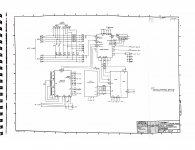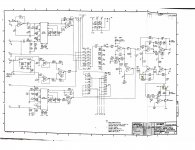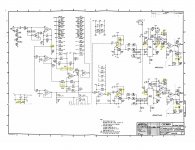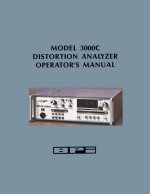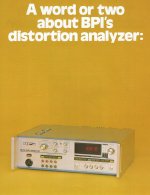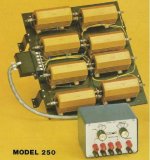I have been repairing a BPI 3000c auto-nulling distortion analyzer and have had to replace quite a few parts to get it working. Overall, things are looking pretty good but I’m having problems with the auto-nulling circuit for frequencies above 7 kHz. The unit should be able to read down to .005% distortion from 20-20,000 Hz. It now works to spec below 7 kHz but won't go below 2% at 20 kHz.
The auto-nulling has an auto-tuning notch filter circuit and an auto-gain circuit both based on optocouplers. Although they both work at lower frequencies, the gain setting reaches it limit on higher frequencies and so about 2% “distortion” remains in the signal after auto-nulling. The remaining waveform significantly shows the fundamental wave. Something is limiting the ability of the circuit to null correctly above 7 kHz. The tuning component appears to be working correctly but the gain circuit runs out of gas before the waveform is fully nulled.
I have spent quite a bit of time on this problem and haven’t figured it out. I have schematics and can explain the circuit topology fairly well but obviously I have some limits to my understanding of how it works.
Does anybody have familiarity with this unit?
Thank you,
John
The auto-nulling has an auto-tuning notch filter circuit and an auto-gain circuit both based on optocouplers. Although they both work at lower frequencies, the gain setting reaches it limit on higher frequencies and so about 2% “distortion” remains in the signal after auto-nulling. The remaining waveform significantly shows the fundamental wave. Something is limiting the ability of the circuit to null correctly above 7 kHz. The tuning component appears to be working correctly but the gain circuit runs out of gas before the waveform is fully nulled.
I have spent quite a bit of time on this problem and haven’t figured it out. I have schematics and can explain the circuit topology fairly well but obviously I have some limits to my understanding of how it works.
Does anybody have familiarity with this unit?
Thank you,
John
I don't have experience with that unit but I do have some experience with those types of problems. Is there a trim on the nulling circuit? Can you get a null at 20 KHz even if you sacrifice at 1 KHz?
The problem will usually be either low gain in the notch at HF or the phase detector is not detecting the phase correctly.
Can you share the schematics or the relevant part of the schematics?
The problem will usually be either low gain in the notch at HF or the phase detector is not detecting the phase correctly.
Can you share the schematics or the relevant part of the schematics?
BPI 3000c Auto-Null
Thanks for taking a look. I have set the nulls at 1 Khz and have not tried at 20 Khz. Attached are the schematics of the two main boards that affect the THD circuitry and the overall unit topology.
John
Thanks for taking a look. I have set the nulls at 1 Khz and have not tried at 20 Khz. Attached are the schematics of the two main boards that affect the THD circuitry and the overall unit topology.
John
Attachments
A few suggestions-
1) get replacement optocouplers. its not easy to crossreference but these guys seem to have the best available today: http://lunainc.com/wp-content/uploads/2016/06/NSL-32.pdf
2) Check the caps for the HF steps, they are all small values so there may be some detuning going on.
3) Opamp upgrades could improve the performance however they can also backfire since the circuit was tuned to the limitations of the opamps in it.
1) get replacement optocouplers. its not easy to crossreference but these guys seem to have the best available today: http://lunainc.com/wp-content/uploads/2016/06/NSL-32.pdf
2) Check the caps for the HF steps, they are all small values so there may be some detuning going on.
3) Opamp upgrades could improve the performance however they can also backfire since the circuit was tuned to the limitations of the opamps in it.
Thank you, Damian.
I have replaced two of the three optocouplers without seeing any changes. The third is on the main board and I will also replace it. After that I'm going to look at the cap values and also the signal contacts on the main frequency selector switch.
I have avoided op amp upgrades because of concern over upsetting the original circuit tuning. I am thinking that op amp frequency response is an unlikely contributor to the problem at audio frequencies. However, there's something lurking in there and I am driven by curiosity, as much as anything else, to figure out what it is.
John
I have replaced two of the three optocouplers without seeing any changes. The third is on the main board and I will also replace it. After that I'm going to look at the cap values and also the signal contacts on the main frequency selector switch.
I have avoided op amp upgrades because of concern over upsetting the original circuit tuning. I am thinking that op amp frequency response is an unlikely contributor to the problem at audio frequencies. However, there's something lurking in there and I am driven by curiosity, as much as anything else, to figure out what it is.
John
Thank you, Damian.
I have replaced two of the three optocouplers without seeing any changes. The third is on the main board and I will also replace it. After that I'm going to look at the cap values and also the signal contacts on the main frequency selector switch.
I have avoided op amp upgrades because of concern over upsetting the original circuit tuning. I am thinking that op amp frequency response is an unlikely contributor to the problem at audio frequencies. However, there's something lurking in there and I am driven by curiosity, as much as anything else, to figure out what it is.
John
Hi John, I was just wondering how it went with repairing your BPI? I have one that I need to do some work on also. I was also wondering where you might have got your set of schematics for it. I've been looking with no luck. Oldiesound shows that they have it, but I tried a few times and could not get it for some reason. Let me know how it went. Any help would be appreciated.
Thanks, Ken
Hi Ken,
Unfortunately, I never figured out the problem 100% but I have a pretty good theory of what the problem is after discussing with a few buddies. Since then, I have been involved in a few other projects and have not returned to see whether my theory will pay off. What issues are you having with your unit?
All the best,
John
Unfortunately, I never figured out the problem 100% but I have a pretty good theory of what the problem is after discussing with a few buddies. Since then, I have been involved in a few other projects and have not returned to see whether my theory will pay off. What issues are you having with your unit?
All the best,
John
Hi John, I know this is a way old thread. I just picked up a bpi 3000c and was wondering if you could share the service/ operations manual? I’ve been looking everywhere but have came up with -0- so far.Hi Ken,
Unfortunately, I never figured out the problem 100% but I have a pretty good theory of what the problem is after discussing with a few buddies. Since then, I have been involved in a few other projects and have not returned to see whether my theory will pay off. What issues are you having with your unit?
All the best,
John
Thanks!
Hi Nightrider64,
I have a copy of the manual and most of the schematics and have uploaded it. The copy I have has one schematic(THD Analyzer and Oscillator) that does not match the board and is missing information. The PDF file is too large to upload to DIYAudio so I will need a way to send it to you.
John
I have a copy of the manual and most of the schematics and have uploaded it. The copy I have has one schematic(THD Analyzer and Oscillator) that does not match the board and is missing information. The PDF file is too large to upload to DIYAudio so I will need a way to send it to you.
John
Hi ejmathews,
Though new to the forum any chance you could help me with service manual for BPI 3000C and 3000A. I own both. One has an IM problem and the other has oscillator issue.
Though new to the forum any chance you could help me with service manual for BPI 3000C and 3000A. I own both. One has an IM problem and the other has oscillator issue.
teklewolde, I also own a BPI 3000A and 3000C. I have the operator's manuals for both and (2) versions of the 3000C sales brochure. The 3000A operator's manual does not include any schematics. The 3000C I have does. At the moment, I own over a dozen audio/distortion analyzers (including HP's, Audio Precisions, etc) and will probably be selling off half of them including my BPI's in the next several months. Likewise, I may sell of one of my BPI-250 precision dummy loads. I also have some history on the company going back to the days when it originally started out as McAdam Electronics.
Here are just a few scans of some of the BPI literature I have.
Please send me a message, so we can discuss this further.
Ed
Here are just a few scans of some of the BPI literature I have.
Please send me a message, so we can discuss this further.
Ed
Attachments
Hi Ed,
Thanks for the response.
Would you be emailing the copy of the SM for C version or post here at diyaudio?
Best regards,
Gedion
Thanks for the response.
Would you be emailing the copy of the SM for C version or post here at diyaudio?
Best regards,
Gedion
- Home
- Design & Build
- Equipment & Tools
- BPI 3000c Distortion Analyzer Auto-Null Problem
